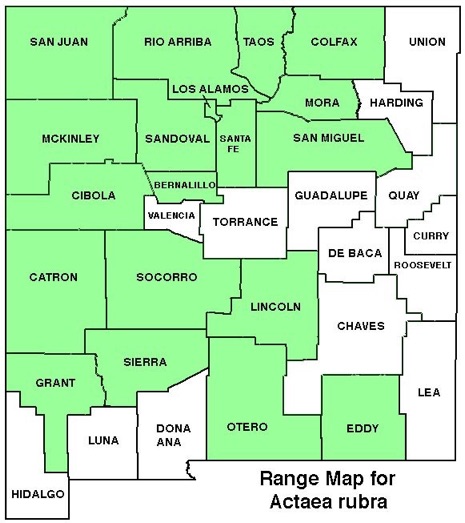WILDFLOWERS OF NEW MEXICO

Clumps of bushy, branching stems rise from a stout, woody stem base and reach 1–3 feet tall with large, compound leaves with serrated edges, and cylindrical clusters of white flowers. Note the berries can be either bright red or snowy white, and are toxic.
FLOWER: April–July. Erect, dense, bottlebrush to pyramidal clusters have 1/2 inch wide (12 mm) flowers on stalks 1/2 inch long (12 mm), 5–10 spoon-shaped petals, and many showy stamens; fruit a cluster of small, rounded, shiny berries, toxic to humans, loved by birds.
LEAVES: Alternate, long-stalked, pinnately divided 1–3 times, 1 1/2 feet long (45 cm); leaflets lance-shaped, 1–4 inches long (3–9 cm), deeply lobed, coarsely toothed, sparsely hairy.
HABITAT: Shady woods, thickets, slopes, moist meadows. stream sides; ponderosa pine-Douglas fir, aspen, spruce-fir forests.
ELEVATION: 8,000–10,500 feet
RANGE: Rocky Mt. states and west, northern tier of states from ND–MA; Canada.
NM COUNTIES: Widespread and common mid- to high-elevation habitats in NM mountains: Bernalillo, Catron, Cibola, Colfax, Eddy, Grant, Lincoln, Los Alamos, McKinley, Mora, Otero, Rio Arriba, San Juan, San Miguel, Sandoval, Santa Fe, Sierra, Socorro, Taos.

BANEBERRY
ACTAEA RUBRA
Buttercup Family, Ranunculaceae
Perennial herb


THE CONTENTS OF THIS WEBSITE ARE COPYRIGHTED AND CANNOT BE USED
WITHOUT PERMISSION OF GEORGE OXFORD MILLER
EMAIL ME

Elongated clusters of berries can be either red or white. Note: Berries are toxic to humans.

Compound leaves have lance-shaped leaflets lined with sharp teeth.
Multiple, branched stems form dense clumps.
